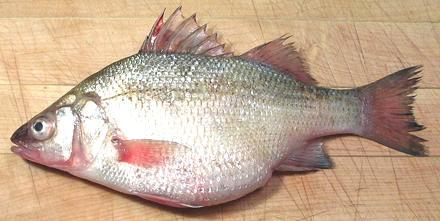 [Morone americana]
[Morone americana]
Not actually a Perch but a Bass, this fish is native to the North Atlantic coast, living in salt, brackish and fresh water, and is an invasive species in the Great Lakes. It is a good eating fish and can be cooked in various ways. The White Perch is not considered threatened, in fact it is considered a nuisance in some areas. It can grow to a little over 19 inches and 4-3/4 pounds, but the photo specimen was 10 inches long and weighed 11 ounces, toward the high end of typical market size.
More on Bass Family
This fish can be filleted and pan fried, pan fried whole or pan dressed, steamed, baked, grilled, or poached whole. When steamed there is so little skin shrink slashes are almost unneeded. The flesh is off white with a thin darker layer just under the skin. It has a pleasant flavor by any means of cooking, but, like other bass, it is not suitable for soups and/or stews.
Buying: This fish can often be found in Asian markets here in Los Angeles, for as little as 2010 US $1.29 / pound. Of course that's a "no cut, no clean" price, so it's all up to the purchaser.
Scales: The scales on this fish are medium size and scrape off quite easily with little flying around.
Cleaning: There are no particular problems gutting this fish, and the gills pull out fairly easily, but you may want to use kitchen shears to cut them loose at the bottom end.
Fillet: This is an easy fish to fillet. When you get to the rib cage just cut the ribs from the backbone with kitchen shears and pull them from the fillet with long nose pliers - they pull fairly easily.
Skin: The skin has modest shrink, but enough to curl a fillet in a frying pan. If you press the fillet back flat with your turner the skin quickly looses its grip and the fillet will continue to fry flat. Fillets can be skinned quite easily with the long knife and cutting board Method, but it does not have a strong or unpleasant flavor, so can be left on for most forms of cooking.
Yield: A 10-7/8 ounce fish yielded 4-1/4 ounces of skin-on fillet (39%) and 3-3/4 ounces skin off (34%). This is not a bad yield for so small a fish.
Stock: The head, bones and fins make a pleasant usable fish stock with almost no oil, but what oil there is should be removed, using you gravy separator. For details see our recipe Making Fish Stock.
sf_perchwz 100421 - www.clovegarden.com